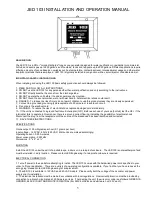
Page 56
Large-scale Decoder & Sound Decoder MX695/6/7/9
CV
Designation
Range
INC-step De-
fault
Description
minimum speed
value defind in CV #381…
#382
Electric brake -
maximum speed
0
– 255
0
…and the value in CV #382
#383
Electric brake -
Pitch
0
– 255
0
= 0: Pitch independent of speed
= 1…255: …depends increasingly on speed.
#384
Electric brake
–
Deceleration
threshold
0
– 255
0
The number of speed steps lowered during decel-
eration before the electric brake sound is played
back.
#385
Electric brake
–
Downhill
0
– 255
0
= 0: no effect at
“negative” load
= 1
– 255: Sound triggered at “negative” load.
#386
Electric brake
–
Loops
0
– 255
0
Bit 3 = 0: Sound fades out at sample end
= 1: Sound ends at with sample end
Bit 2…0: Increases minimum playback time by 0 …
7 seconds, to prevent an interruption in break
sound between speed steps.
Coasting
and
Notching
functions are required for driving situtations
where the engine sound
cannot be derived from speed, acceleration and load only.
Primarily in diesel locomotives (but not
necessarily limited to diesels), the motor’s idle sound or a
certain specified speed step sound is enforced by keystroke.
This method can be used for “downshifting” (often to neutral) as well as “upshifting” (i.e. elevated
idle for heating). Future software versions will expand this function to a fully independent sound
effect.
CV
Designation
Range Default Description
#374
Coasting-Key
(or Notching)
0 - 28
0
Function key that activates “Coasting“, which forces the mo-
tor sound
to a specified speed independent of the driving
situation. Define the (sound) speed in CV #375 (often used
for idle sound while coasting).
= 0: does NOT mean F0, but rather that NO key is assigned
for coasting.
= 1 ... 28: One of the function keys F1 … F28 for “Coasting“
# 375
Coasting-Step
(or Notching)
0 - 10
0
Motor speed (sound) to be activated with coasting key (as
per CV #374), independent of driving situation.
= 0: Idle sound (typical coasting situations)
= 1 … 10: Sound speed (Diesel engines typically have 5 to
10 notches, which can be activated with the coasting key.
#398
Automatic Coasting
0
– 255
0
The number of speed steps the train’s speed has to be re-
duced within 0.5 seconds in order for the automatic coasting
effect to set the motor sound to idle (without assigning a
coasting key above). The motor sound will not return to idle
if the speed is reduced at a slower rate.
It is especially convenient if the
sound step can be raised manually
with a function key when
operating diesel engines.
CV
Designation
Range Default Description
#339
Key assignment for
raising diesel step
0 - 28
0
Define a function key that raises the diesel motor to the min-
imum step defined in CV #340.
See below if more function keys are needed to raise the
sound further.
#340
Define diesel step
and possibly more
key assignments
0 - 10
0
Minimum step the sound of the diesel motor should increase
to with the key defined in CV #339. These steps are not mo-
tor speed steps but rather sound steps. A sound library can
have 1 to 10 speed (sound) steps (i.e. “1” forces the sound
to sound step 1, “2” to sound step 2 etc.). The sound can
only be increased with these keys. For sound decrease, use
the coasting functions in the table above.
To add more function keys for more speed increases use
this calculation:
Lowest speed (sound) step for the first key defined in CV
#339 + (16 * (number of keys
– 1)).
Example: F4 is defined as the first key in CV #339, which is
supposed to raise the speed from idle to the first cruise step.
To add 3 more keys (F5 to 2
nd
cruise step, F6 to 3
rd
, F7 to
4
th
): 1 (first cruise step above idle) + 63 (4 * 16
– 1) = 64.
7.8
Random and Switch input sounds
#315
Minimum interval for
random generator Z1
0 - 255
=
0 - 255 sec
1
The random generator generates internal pulses in irregular
intervals that are used to playback a sound file assigned to
the random generator. CV #315 defines the shortest possible
interval between two consecutive pulses.
Sound samples are assigned to the random generator Z1 with
the help of the procedure CV #300 = 101, see above! By de-
fault, the compressor is assigned to Z1.
Special note to random generator Z1:
The random generator Z1 is optimized for the compressor
(which should be played back shortly after the train has
stopped); therefore the default assignment should be retained
or at the most be used for a different compressor. CV #315
also determines the proper time the compressor is started af-
ter coming to a stop!
#316
Maximum interval
for random generator
Z1
0 - 255
=
0 - 255 sec
60
CV #316 defines the maximum time interval between two
consecutive pulses of the random generator Z1 (that is most
often the start of the compressor after coming to a stop); the
actually occurring pulses between the values in CV #315 and
#316 are equally distributed.
Summary of Contents for MX695
Page 6: ...Page 6 Large scale Decoder Sound Decoder MX695 6 7 9 ...
Page 7: ...Large scale Decoder Sound Decoder MX695 MX696 MX697 MX699 Page 7 MX697 ...
Page 8: ...Page 8 Large scale Decoder Sound Decoder MX695 6 7 9 ...
Page 14: ...Page 14 Large scale Decoder Sound Decoder MX695 6 7 9 ...
Page 15: ...Large scale Decoder Sound Decoder MX695 MX696 MX697 MX699 Page 15 ...






































